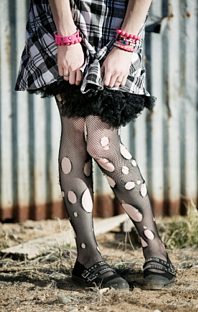Grunge fashion is believed to have originated in the United States in the early 1990s. Likely beginning in Seattle, Washington, the fashion came out of the financial hardships of the times, combined with the regional growth of alternative rock music made popular by bands like Nirvana and Pearl Jam. The style combines elements of punk mixed with inexpensive working class clothing, like jeans and plaid fabrics. The development of grunge also brought back the ripped and shredded clothing popular during the early 1980s. At its height, grunge was in many ways a rejection of the capitalist excesses of the 1980s, but the style was quickly picked up by designers and turned into a well-known fashion trend.
The Essentials
Perhaps the main element to this style is an unkempt look, and in many cases, pieces of clothing are paired together that don't match. The look often has a thrift store vibe, with lots of layering. For instance, a long-sleeved T-shirt might be worn under a tank top, topped off with a baggy cardigan sweater or hoodie jacket. A plaid shirt or sweater might be tied around the waist.
 One of the most recognizable elements of grunge fashion is the plaid flannel shirt. Usually over-sized and worn untucked, it can be layered over a T-shirt or long-sleeved thermal undershirt. The plaid patterns on these shirts are usually relatively large in scale, the colors muted, and the fabric faded and worn. Flannel is a popular fabric used for grunge plaids because it is available in so many different colors and is usually inexpensive. Other plaid fabrics might include wool or cotton blends.
One of the most recognizable elements of grunge fashion is the plaid flannel shirt. Usually over-sized and worn untucked, it can be layered over a T-shirt or long-sleeved thermal undershirt. The plaid patterns on these shirts are usually relatively large in scale, the colors muted, and the fabric faded and worn. Flannel is a popular fabric used for grunge plaids because it is available in so many different colors and is usually inexpensive. Other plaid fabrics might include wool or cotton blends.
Jeans are another important element. Most of the time, jeans should be loose and well worn, with rips or holes. To achieve the look with less time, jeans can be intentionally cut or ripped, and then washed repeatedly until the cut edges begin to unravel and fray. In addition, they can be soaked in bleach for a couple of hours, then washed and dried. This process will result in the fabric fading and looking much more worn.
In addition to ragged jeans and plaid shirts, women can wear "granny dresses," which are long, loose-fitting cotton dresses, often with a flowered pattern. On the other end of the spectrum, short slip dresses and baby doll dresses might be paired with ripped tights or leggings. Tartan kilts are another good option, for both men and women.
Shoes
 Grunge footwear typically consists of worn-out high top tennis shoes or scuffed combat boots — for both men and women. The Dr. Martens brand is closely associated with this look. The more worn out the footwear, the better suited it is for grunge. If worn, stockings are usually torn tights or colored knee socks.
Grunge footwear typically consists of worn-out high top tennis shoes or scuffed combat boots — for both men and women. The Dr. Martens brand is closely associated with this look. The more worn out the footwear, the better suited it is for grunge. If worn, stockings are usually torn tights or colored knee socks.
Hair and Accessories
Grunge hairstyles for both men and women are usually messy and limp. Hair is usually worn long and loose, and may look like it hasn't been brushed or washed in several days. Bleached or dyed hair is also a common element, although the color may be uneven or grown out, as fits the unkempt style.
Hats are seldom included in grunge, with the exception of baseball caps or beanies. Jewelry also has no real place, though some simple Gothic pieces or leather wristbands are sometimes used. Modern grunge makeup is often characterized by heavy black eyeliner and mascara, with a smudged, "out all night" look.
The Grunge Attitude
Putting a grunge look together is usually cheap to do, as the whole concept revolves around inexpensive clothing and accessories. Unlike many other fashion trends, other than plaid, there appears to be no true constant in grunge. Any article of clothing that can add to the appearance of unkempt fashion will often suffice.
Traditionally, grunge fashion also comes with an attitude. The look is often dark and edgy, and suggests that the wearer isn't concerned with being fashionable or spending a lot of money on how he looks. Clothing is inexpensive, worn, and often ill-fitting, since it was probably bought at a thrift store or borrowed from a friend. The style is also a reflection of the financial situation faced by a generation of young people in the Pacific Northwest in the early 1990s.
Designer Grunge
Associated as it was with popular rock and roll musicians, the grunge style was quickly picked up by designers, like Marc Jacobs and Anna Sui, who released high-end fashions based on the look. Rather than inexpensive, thrift-store finds, grunge turned into something that was showcased on catwalks and sold in expensive boutiques. The fabrics were silks instead of cottons, but the distressed jeans and ripped tights — and the plaid — remained.
Grunge fashion became less popular by the mid-1990s, particularly as the economic climate improved and dressing cheaply no longer was a necessity for as many people. As with many fashion trends, however, some elements of grunge have never really gone away, and the style has been adapted and repurposed into "neo grunge" and "glunge" — glamorous grunge — styles. During the global economic recession of the early 2010s, grunge-inspired looks returned to the catwalk as well.
Videos
How To Dress, Glunge (Glamour + Grunge):
Neo Grunge:
The Return of Grunge:









